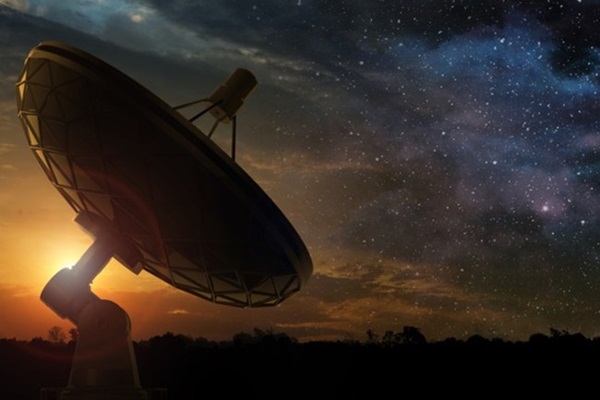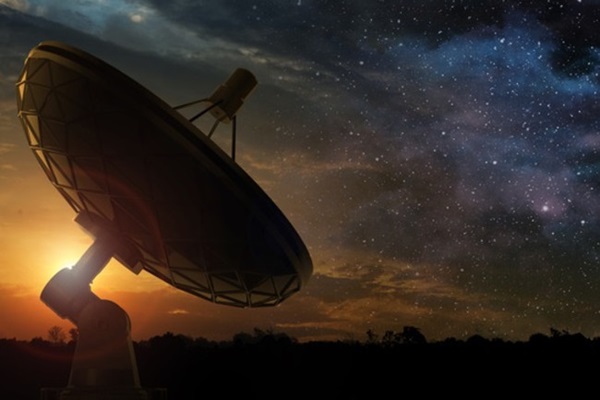
A telescope scans the sky in search of signals sent from advanced alien civilizations in this artist’s concept. Credit: paulista/Shutterstock.
Don’t bother wondering if alien civilizations can hear our radio broadcasts or not. According to a new study, sufficiently advanced aliens can already see us.
The research, set to be published to the journal Acta Astronomica, starts with a very basic assumption: that the laws of physics as we currently understand them are largely correct and hold across the universe. While this might not be true, anything past that assumption would be largely groundless speculation, so it’s as good a starting point as any.
This assumption allows us to conclude that if an alien civilization wants to directly observe us, then they’re going to need a big telescope. Us humans have built a variety of large structures on and around our planet, like the great pyramids, skyscrapers, and spacecraft (the authors did not discuss larger, more visible signs of technological development, like roads, canals, and farms). If aliens had a similar level of technology to ourselves, they might detect something funny in the spectrum of light coming from the Earth, but their image of our planet would be just a tiny dot. If they really wanted to see if we were up to something interesting, they would need a lot more resolution.
In astronomy to get more resolution we need bigger optics. To have the resolving power to take a picture of the pyramids, however, an alien civilization sitting hundreds of thousands of light-years away will need a telescope roughly ten times greater than the orbit of the Earth. This is an understandably daunting task, even for highly advanced aliens, so instead they can opt for a technique called long-baseline interferometry, where astronomers send multiple telescopes very far from each other and observe the same target, combining the data later to make a coherent image.
Earth astronomers have had great success using this technique at radio wavelengths, but we do not have the technological sophistication necessary to apply the technique to visible wavelengths of light, because we cannot record the information fast enough. But advanced aliens might just be able to do the trick, according to the researchers.
A nice view of ancient Egypt for a curious alien
Aliens can only see what we’ve built after we’ve already built it, and it takes time for those light signals from our constructions to make their way out into the cosmos. That sets an upper limit on the distance of our visibility to any other civilization. For example, the great pyramids of Giza were built roughly 3,000 years ago, and so aliens have to be within 3,000 light-years to be able to see them. Similarly, aliens farther than roughly 100 light-years can’t see our skyscrapers, and farther than a few tens of light-years couldn’t pick out our orbiting space stations.
So the question of our visibility becomes whether a sufficiently advanced civilization sits within any of those bubbles.
Life may or may not be common in the universe. At the present time we have no evidence whatsoever of any life existing outside the Earth, so we can only guess. Presumably, and this is only a guess, intelligence is even rarer than life. And sophisticated intelligence is even rarer. The Kardashev scale gives us a sense of different levels of sophistication of a species, and from there we can estimate how common those levels are.
For example, a Kardashev Type-I civilization can harness the energy equivalent to the total solar energy hitting their planet’s surface. The authors of the paper argue that such a civilization could not construct a powerful enough telescope, so even if they’re nearby, they won’t see us.
Next up the ladder is a Type-II civilization, which can use all the energy output of a typical star. These civilizations just might have the sophistication to directly observe us from hundreds or thousands of light-years away, but they are probably much rarer than their less sophisticated cousins.
Our visibility comes down to the number of Type-II civilizations nearby. If, for example, there are millions of such civilizations currently inhabiting the Milky Way, then conceivably one of them could be within the bubble of a few thousand light-years, and they could, at this very moment, be watching as the ancient Egyptians build their first pyramids.
If advanced civilizations are less common, however, then the average distance between intelligent aliens is so large that even the nearest one likely sits outside out visibility bubble, and they don’t know yet that intelligent creatures have started large-scale engineering projects on the Earth. They’re just going to have to wait.

